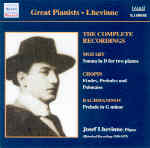Finally! Naxos blesses us with the first decent-sounding CD transfers of the legendary Josef Lhevinne’s complete studio recordings, a slender yet priceless legacy that belongs in every, and I mean every serious piano collection. When Philips brought out the Lhevinne discs in its Great Pianists of the Twentieth Century series, it basically copied the poorly remastered, long-deleted reissue on Novello. By contrast, Ward Marston’s Naxos transfers do full justice to the original shellacs.
It’s not just Lhevinne’s spectacular technique that amazes, but his sense of style, his diamond-like sonority, his unassailable authority and command. For instance, listen to the incredible ease with which he dispatches Frühlingsnacht’s repeated notes, creating soaring lines where others merely pound. Or how elegantly he delineates the knotty textural strands in Schumann’s Toccata, eschewing Horowitz’s nervous energy or Simon Barere’s mad dash to the finish line.
In Chopin’s E-flat Etude (mistitled Op. 10 No. 6 on the jacket) you hear Lhevinne shape every note of the cruelly exposed arpeggiated chords with specificity and purpose. His Op. 25 No. 6 makes most other recordings of this double-note litmus test sound thick, even when he doubles the descending A major scale toward the end with his left hand. The Octave Etude’s middle section is quicker and more forcefully projected than the norm, while Lhevinne’s double-octave technique proves that power and finesse are not mutually exclusive entities.
Lhevinne’s Winter Wind Etude and B-flat minor Prelude are models of rhythmic vivacity and lapidarian detail. The A-flat Polonaise, though compartively poker-faced next to more ardent, extroverted 78-era versions (Rubinstein, Friedman), is hair-raisingly honest from a technical standpoint. The Blue Danube was to Lhevinne as The Stars and Stripes Forever was to Horowitz, and I’ve yet to encounter any pianist (living or dead) to match Lhevinne’s straightforward lilt, effortless proportioning of tune and filigree, and utterly offhanded technique. This recording, incidentally, is slightly abdridged and omits the cascading introduction Lhevinne included in his piano roll version. The four rare acoustic Pathé sides showcase Lhevinne’s cultivated artistry in less demanding repertoire. Lastly, the Mozart and Debussy items with Josef and Rosina Lhevinne offer well-honed ensemble values and splendid synchronicity. Absolutely essential, especially at Naxos’ rock-bottom price.
































